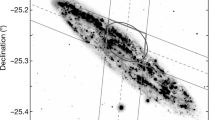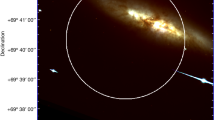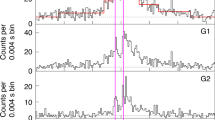Abstract
Soft-γ-ray repeaters (SGRs) are galactic X-ray stars that emit numerous short-duration (about 0.1 s) bursts of hard X-rays during sporadic active periods. They are thought to be magnetars: strongly magnetized neutron stars with emissions powered by the dissipation of magnetic energy. Here we report the detection of a long (380 s) giant flare from SGR 1806–20, which was much more luminous than any previous transient event observed in our Galaxy. (In the first 0.2 s, the flare released as much energy as the Sun radiates in a quarter of a million years.) Its power can be explained by a catastrophic instability involving global crust failure and magnetic reconnection on a magnetar, with possible large-scale untwisting of magnetic field lines outside the star. From a great distance this event would appear to be a short-duration, hard-spectrum cosmic γ-ray burst. At least a significant fraction of the mysterious short-duration γ-ray bursts may therefore come from extragalactic magnetars.
This is a preview of subscription content, access via your institution
Access options
Subscribe to this journal
Receive 51 print issues and online access
$199.00 per year
only $3.90 per issue
Buy this article
- Purchase on Springer Link
- Instant access to full article PDF
Prices may be subject to local taxes which are calculated during checkout





Similar content being viewed by others
References
Duncan, R. & Thompson, C. Formation of very strongly magnetized neutron stars: implications for gamma-ray bursts. Astrophys. J. 392, L9–L13 (1992)
Kouveliotou, C. et al. An X-ray pulsar with a superstrong magnetic field in the soft gamma-ray repeater SGR 1806–20. Nature 393, 235–237 (1998)
Thompson, C. & Duncan, R. The soft gamma repeaters as very strongly magnetized neutron stars. I. Radiative mechanism for outbursts. Mon. Not. R. Astron. Soc. 275, 255–300 (1995)
Kouveliotou, C. et al. Discovery of a magnetar associated with the soft gamma repeater SGR1900 + 14. Astrophys. J. 510, L115–L118 (1999)
Thompson, C. & Duncan, R. Neutron star dynamos and the origins of pulsar magnetism. Astrophys. J. 408, 194–224 (1993)
Thompson, C. & Duncan, R. C. The soft gamma repeaters as very strongly magnetized neutron stars II. Quiescent neutrino, X-ray and Alfvén wave emission. Astrophys. J. 473, 322–342 (1996)
Mazets, E. et al. A flaring X-ray pulsar in Dorado. Nature 282, 587–589 (1979)
Hurley, K. et al. A giant periodic flare from the soft γ-ray repeater SGR 1900 + 14. Nature 397, 41–43 (1999)
Evans, W. et al. Location of the gamma-ray transient event of 1979 March 5. Astrophys. J. 237, L7–L9 (1980)
Vrba, F. et al. The discovery of an embedded cluster of high-mass stars near SGR1900 + 14. Astrophys. J. 533, L17–L20 (2000)
Borkowski, J. et al. Giant flare from SGR1806–20 detected by INTEGRAL. GCN Circ. 2920 (2004)
Hurley, K. et al. IPN localization of the giant flare from SGR1806–20. GCN Circ. 2921 (2004)
Boggs, S. et al. SGR1806–20, RHESSI observations of the 041227 giant flare. GCN Circ. 2936 (2004)
Mazets, E. et al. The giant outburst from SGR1806–20. GCN Circ. 2922 (2004)
Palmer, D. et al. A giant γ-ray flare from the magnetar SGR 1806–20. Nature doi:10.1038/nature03525 (this issue)
Corbel, S. & Eikenberry, S. The connection between W31, SGR 1806–20, and LBV 1806–20: Distance, extinction, and structure. Astron. Astrophys. 419, 191–201 (2004)
Figer, D. F., Najarro, F. & Kudritzki, R. P. The double-lined spectrum of LBV 1806–20. Astrophys. J. 610, L109–L113 (2004)
Cline, T. et al. Detection of a fast, intense and unusual gamma ray transient. Astrophys. J. 237, L1–L5 (1980)
Thompson, C. & Duncan, R. The giant flare of 1998 August 27 from SGR1900 + 14. Radiative mechanism and physical constraints on the source. Astrophys. J. 561, 980–1005 (2001)
Terasawa, T. et al. Repeated injections of energy in the first 600 ms of the giant flare of SGR 1806–20. Nature doi:10.1038/nature03573 (this issue); preprint at http://arXiv.org/astro-ph/0502315 (2004).
Barat, C. et al. Fine time structure in the 1979 March 5 gamma ray burst. Astron. Astrophys. 126, 400–402 (1983)
Paczyński, B. Gamma-ray bursters at cosmological distances. Astrophys. J. 308, L43–L46 (1986)
Gaensler, B. M. et al. An expanding radio nebula produced by a giant flare from the magnetar SGR 1806–20. Nature doi:10.1038/nature03498 (this issue)
Boggs, S. et al. The giant flare of December 27, 2004 from SGR 1806–20. Astrophys. J. (submitted)
Gogus, E. et al. Temporal and spectral characteristics of short bursts from the soft gamma repeaters 1806–20 and 1900 + 14. Astrophys. J. 558, 228–236 (2001)
Thompson, C., Lyutikov, M. & Kulkarni, S. Electrodynamics of magnetars: implications for the persistent X-ray emission and spin-down of the soft gamma repeaters and anomalous X-ray pulsars. Astrophys. J. 574, 332–355 (2002)
Golenetskii, S. et al. Bright bursts from SGR1806–20. GCN Circ. 2823 (2004)
Woods, P. et al. Gradual brightening of SGR1806–20. Astronomer's Telegram 313 (2004)
Lyutikov, M. Explosive reconnection in magnetars. Mon. Not. R. Astron. Soc. 346, 540–554 (1998)
Woods, P. M. et al. Large torque variations in two soft gamma repeaters. Astrophys. J. 576, 381–390 (2002)
Duncan, R. Gamma-ray bursts from extragalactic magnetar flares. AIP Conf. Proc. 586, 495–501 (eds Martel, H. & Wheeler, J. C.) (AIP, New York, 2001).
Eichler, D. Waiting for the big one: a new class of soft gamma repeater outbursts. Mon. Not. R. Astron. Soc. 576, 381–392 (2002)
Mazets, E., Golenetskii, S., Guryan, Yu. & Ilyinskii, V. The 5 March 1979 event and the distinct class of short gamma bursts—are they of the same origin? Astrophys. Space Sci. 84, 173–189 (1982)
Dezalay, J.-P. et al. The hardness-duration diagram of gamma-ray bursts. Astrophys. J. 471, L27–L30 (1996)
Norris, J., Cline, T., Desai, U. & Teegarden, B. Frequency of fast, narrow gamma ray bursts. Nature 308, 434–435 (1984)
Hurley, K. Gamma-ray burst observations: past and future, in gamma-ray bursts. AIP Conf. Proc. 265, 3–12 (eds Paciesas, W. & Fishman, G.) (AIP, New York, 1992).
Kouveliotou, C. et al. Identification of two classes of gamma-ray bursts. Astrophys. J. 413, L101–L104 (1993)
Hurley, K. et al. Afterglow upper limits for four short-duration, hard spectrum gamma-ray bursts. Astrophys. J. 567, 447–453 (2002)
Paciesas, W. et al. The Fourth BATSE Gamma-Ray Burst Catalog (Revised). Astrophys. J. Suppl. 122, 465–495 (1999)
Fishman, G. et al. The first BATSE gamma-ray burst catalog. Astrophys. J. Suppl. 92, 229–283 (1994)
Cross, N. & Driver, S. P. The bivariate brightness function of galaxies. Mon. Not. R. Astron. Soc. 329, 579–598 (2002)
Lazzati, D., Ramirez-Ruiz, E. & Ghisellini, G. Possible detection of hard X-ray afterglows of short gamma-ray bursts. Astron. Astrophys. 379, L39–L43 (2001)
Connaughton, V. BATSE observations of gamma-ray burst tails. Astrophys. J. 567, 1028–1036 (2002)
Gehrels, N. et al. The Swift gamma-ray burst mission. Astrophys. J. 611, 1005–1020 (2004)
Fenimore, E. et al. Swift's ability to detect gamma-ray bursts. Preprint at http://arXiv.org/astro-ph/0408513 (2004).
Woods, P. et al. Evidence for a sudden magnetic field reconfiguration in soft gamma repeater SGR1900 + 14. Astrophys. J. 552, 748–755 (2001)
Lyubarsky, Y., Eichler, D. & Thompson, C. Diagnosing magnetars with transient cooling. Astrophys. J. 580, L69–L72 (2002)
Lenters, G. T. et al. An extended burst tail from SGR 1900 + 14 with a thermal X-ray spectrum. Astrophys. J. 587, 761–778 (2003)
Feroci, M., Hurley, K., Duncan, R. & Thompson, C. The giant flare of 1998 August 27 from SGR1900 + 14. I. An interpretive study of BeppoSAX and Ulysses observations. Astrophys. J. 549, 1021–1038 (2001)
Kulkarni, S. et al. The quiescent counterpart of the soft gamma repeater SGR 0526–66. Astrophys. J. 585, 948–954 (2003)
Golenetskii, S., Ilyinskii, V. & Mazets, E. Recurrent bursts in GBS0526–66, the source of the 5 March 1979 γ-ray burst. Nature 307, 41–43 (1984)
Lin, R. et al. A three dimensional plasma and energetic particle experiment for the Wind spacecraft. Space Sci. Rev. 71, 125–153 (1995)
Cameron, P. B. et al. Detection of a radio counterpart to the 27 December 2004 giant flare from SGR 1806–20. Nature doi:10.1038/nature03605 (this issue)
Acknowledgements
We are grateful to J. Scalo, E. Vishniac and S. Kannappan for discussions and expert help. In the US, this work was supported by NASA. The INTEGRAL mission is supported by the German government via the DLR agency.
Author information
Authors and Affiliations
Corresponding author
Ethics declarations
Competing interests
The authors declare that they have no competing financial interests.
Supplementary information
Supplementary Notes
This contains information on the detectors, their count rates, their dead times, and other details of the observations. It also explains the details of the calculations used to derive the detectability and rate of magnetar bursts. (DOC 32 kb)
Rights and permissions
About this article
Cite this article
Hurley, K., Boggs, S., Smith, D. et al. An exceptionally bright flare from SGR 1806–20 and the origins of short-duration γ-ray bursts. Nature 434, 1098–1103 (2005). https://doi.org/10.1038/nature03519
Received:
Accepted:
Issue Date:
DOI: https://doi.org/10.1038/nature03519
This article is cited by
-
Luminosity distribution of fast radio bursts from CHIME/FRB Catalog 1 by means of the updated Macquart relation
Astrophysics and Space Science (2022)
-
A peculiar hard X-ray counterpart of a Galactic fast radio burst
Nature Astronomy (2021)
-
Cosmic electromagnetic bomb sheds light on the origins of γ-ray bursts
Nature (2021)
-
A bright γ-ray flare interpreted as a giant magnetar flare in NGC 253
Nature (2021)
Comments
By submitting a comment you agree to abide by our Terms and Community Guidelines. If you find something abusive or that does not comply with our terms or guidelines please flag it as inappropriate.



